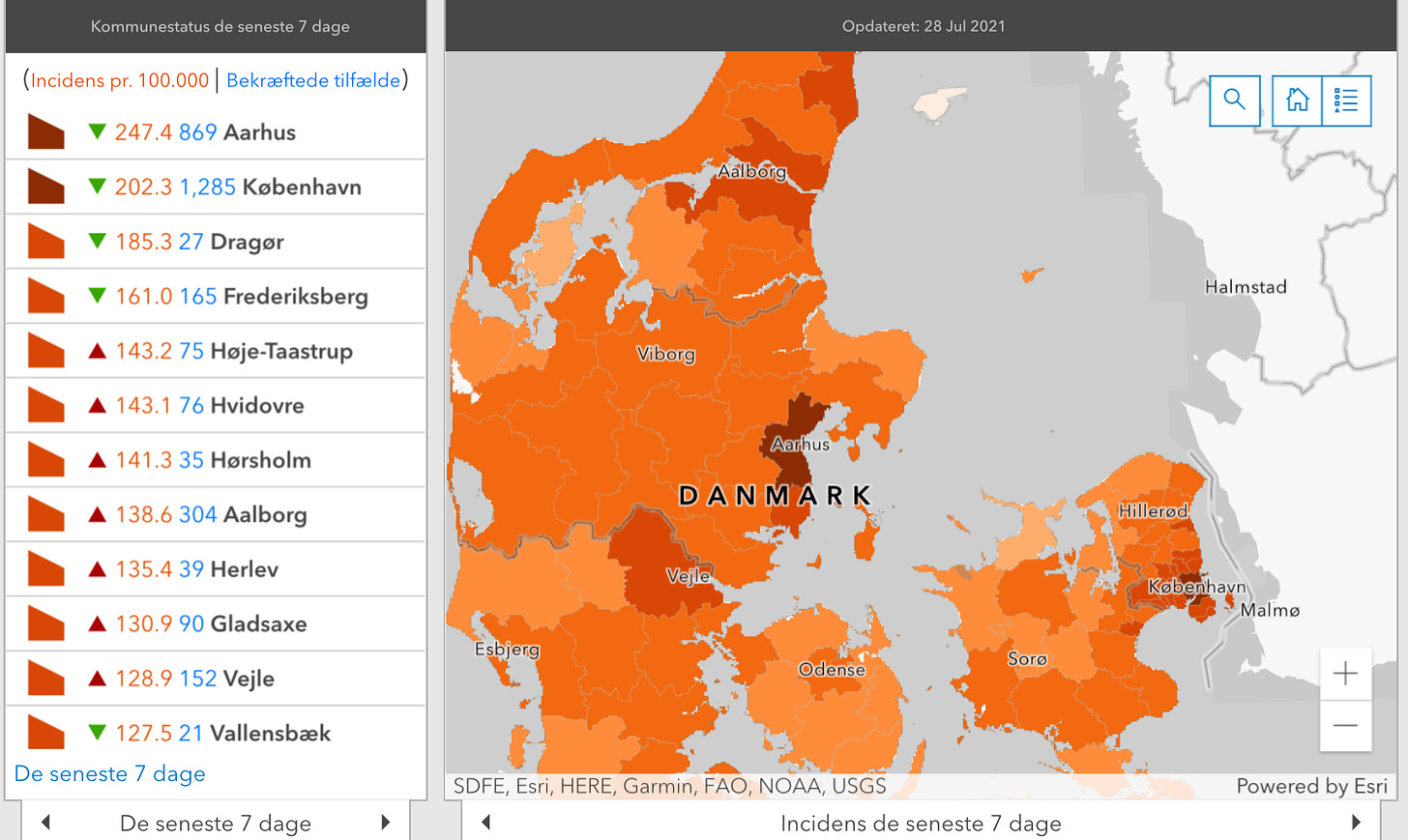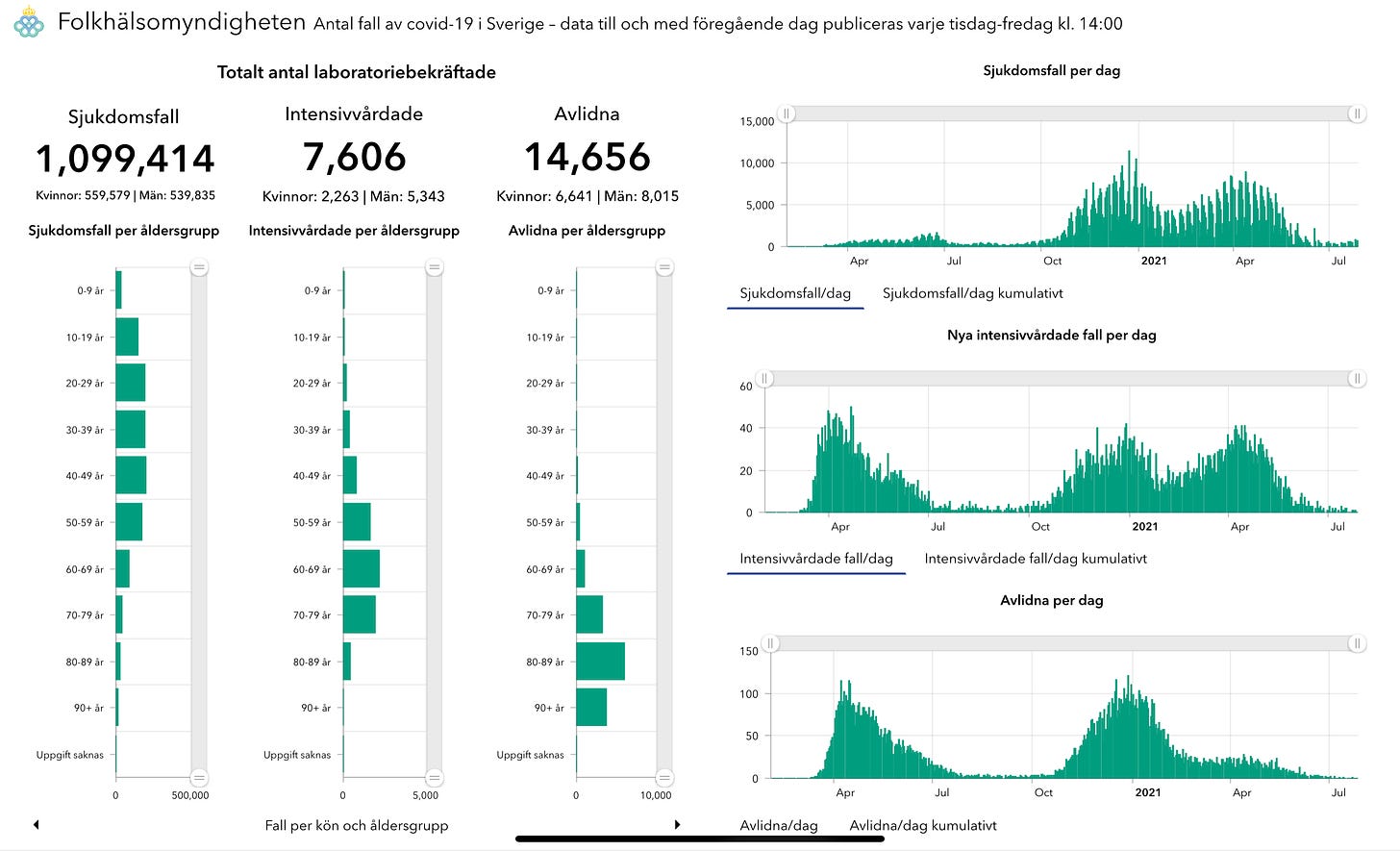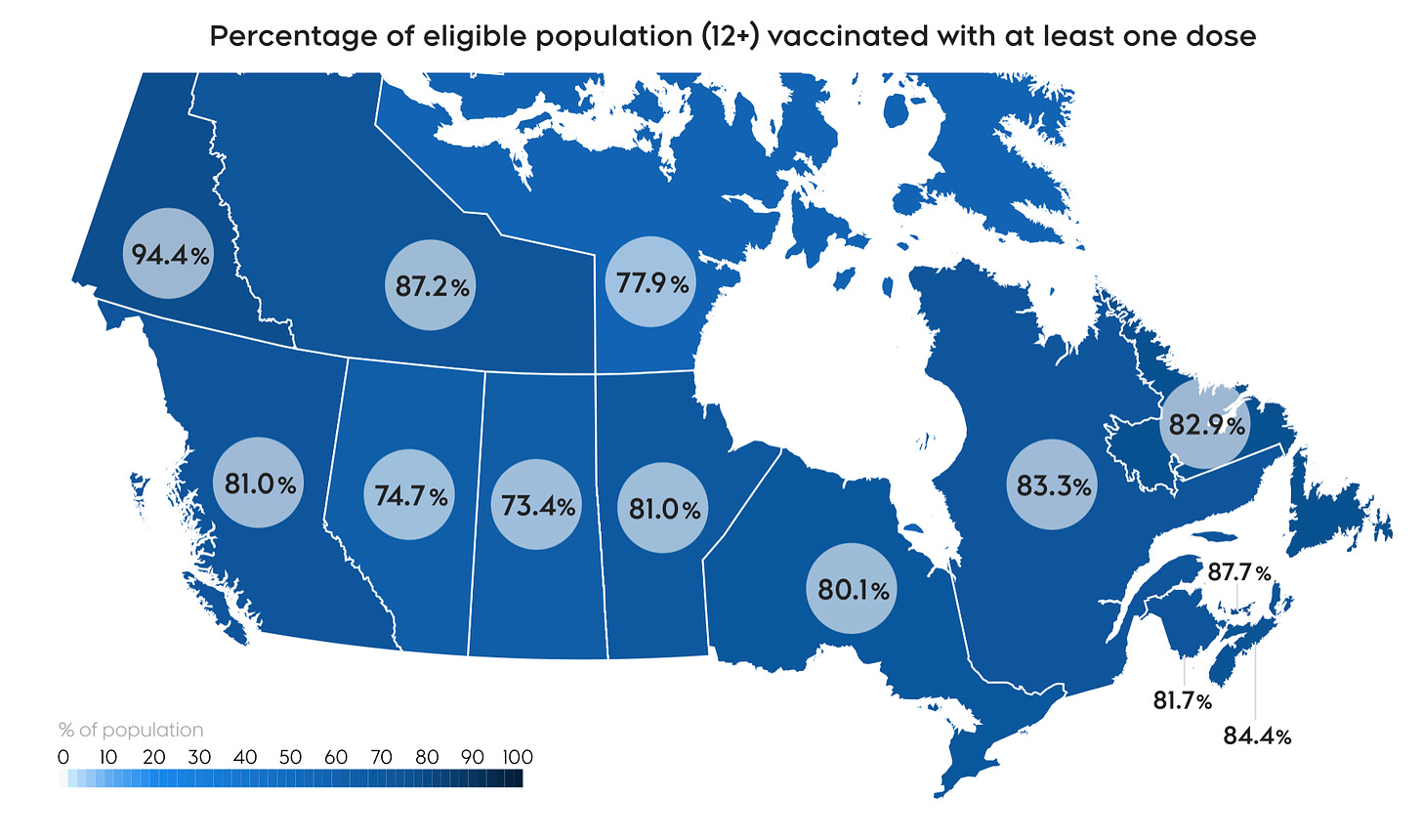🇩🇰
The latest Staten Serum Institut variant update has found another 5,192 cases of the Delta variant have been confirmed in Denmark, pushing to date total case numbers to 12,719.
The Delta variant now accounts for 91% of all sequenced positive test results in Denmark.
As Delta rises Alpha falls. The variant first identified in the United Kingdom and responsible for driving a third infection wave around the globe has all but vanished in Denmark as Delta takes over.
The SSI says they have confirmed one case of a further mutated Delta variant called AY.1 or Delta Plus.
-
Denmark’s National Health Board has reviewed all the latest data on vaccinating adolescents 12-to 15-year olds and is more convinced than ever mRNA vaccines are safe and effective. The data come from Israel, Canada, and the USA, which have vaccinated millions of young children between them.
Director Søren Brostrøm says vaccinating young people isn’t just safe, it makes society safer, especially with the Delta variant.
“The dominance of the more contagious Delta variant has only further substantiated the need for a greater degree of population immunity. When Denmark returns from holiday in a little while, society, and schools will resume. At the same time, the seasonal effect diminishes, and in the autumn and winter, both COVID and influenza can flare up, also despite large vaccine coverage in risk groups. Furthermore, we have only been further reassured by the safety of using mRNA vaccines in children. So I have a clear recommendation for all 12-15 year olds and their parents: get vaccinated before school starts!”
The health board says more than a third (36%) of all 12-to 15-year olds in Denmark have either booked a vaccination appointment or have had their first shot.
-
Denmark has added 2,132 new COVID infections and two more coronavirus deaths in the last two days. It reported a sudden surge of 1,284 infections yesterday and then another 848 today.
Yesterday there were 172,116 total corona tests done, 56,368 PCR and 115,748 rapid, for a (PCR only) positivity percentage of 1.50%, which is very high.
The number of Danish kommunes seeing COVID incidence rates above 100 per 100,000 residents has increased to 24. Among them, Copenhagen has also joined Aarhus in having a COVID incidence rate above 200.
COVID hospitalizations (57) have fallen (-7) while the number of infected people in an ICU (10) and of those on a ventilator (5) are both unchanged day to day.
-
On the vaccination front to date, 71.2% of the total Danish population has one vaccine dose while 53% are now fully vaccinated.
Yesterday, there were 62,241 total inoculations done as vaccination demand continues to fall off in Denmark.
-
The Staten Serum Institut is launching what it calls the “largest and most detailed and comprehensive” study of pandemic impacts on health, especially for those suffering from long-COVID. The institut says the ‘After-COVID’ study will begin August 1st when questionnaires will be sent out to 600,000 people “who have been tested for COVID.”
Professor Anders Hviid:
“The value of our survey depends to a large extent on the fact that many people answer the questionnaires. Whether people have been infected or not, their participation is absolutely crucial to the success of the study. Therefore, we very much hope that many Danes can see the value in helping to clarify how the epidemic has affected the population's health.”
The hope is the study will clarify the impacts of those who suffer from corona symptoms long after recovery, called long-COVID.
“If we get a clearer picture of the late effects, it will be a huge help to determine what role covid-19 has played for the Danes' health, and it can hopefully also be a stepping stone to both prevent late effects and to help those who has had late effects.”
The study will also look at the overall health impacts of the pandemic, asking participants about their health before and after infection and then follow up with them over an 18-month period.
-
Skagen leads all PCR testing centers in Denmark with the highest positivity percentage.
Region Nordjylland says the summer tourism season has resulted in a lot of “close contacts” in week 29, causing it to amp up COVID testing in Skagen. Until Wednesday next week, PCR testing will be available every day at Skagen City Hall. Tests can be done with or without an appointment.
🇸🇪
Sweden has added 1,260 infections and one more corona death since Tuesday’s update.
There are 17 people in an ICU in Sweden, an increase of one.
To date, 6,365,362 1st doses (77.7% of the population) and 4,118,142 2nd vaccine doses (50.3%) have been administered.
-
In Southern Sweden, the Blekinge Region has announced that it will begin vaccinations for young people aged 16-to 17-years old. The Swedish Public Health Agency recently lowered the age of those eligible for vaccinations from 18 years old down to 16. It is up to the different Swedish regions to decide when they will begin inoculating the new age group.
-
COVID infections have risen for a fifth week in a row in Region Stockholm. The region says 1,126 new infections were confirmed last week, with 34 people in hospital. There were no new deaths in the past week. The health authority says COVID infections have increased by 60% in just the last two weeks.
Infection Control Doctor Maria Rotzén Östlund:
“Each of us has the opportunity - and responsibility - to contribute to reducing the spread of infection again. You can do this by getting vaccinated. Use the next few rainy days to vaccinate yourself if you have not already done so, this applies to both you who have not yet taken your first dose and you who for some reason have postponed your second dose. Today, the Delta variant dominates in Stockholm. We know that it is more contagious, but also that the vaccine provides good protection after two doses.”
So far, 1,169 confirmed cases of the Delta variant have been confirmed in Sweden’s capital region. But the country continues to not only see a reporting lag but also continues to deal with a significant backlog of sequencing results. This means variant numbers being reported now are very likely several weeks out of date.
-
In Sweden, the rise of the Delta variant has prompted authorities to reduce the interval between first and second vaccine doses. In Region Stockholm as of today, people can have a second shot four weeks after their first. The region says this will mean more people can become fully vaccinated faster and have maximum protection against the fast-spreading and much more contagious Delta variant. People in the region don’t need to do anything other than book their second shot as soon as they are sent an SMS that they can do so.
As the region phases out use of the AstraZeneca vaccine seniors 65 years old and older can now also choose to have an mRNA vaccine as their second dose.
🇳🇴
Norway has added 704 infections and has had no new virus deaths since Tuesday.
COVID hospitalizations (25) have increased (+4) while ICU number (6) have inched downward (-1) of those the number on a ventilator (3) has also edged down (-1).
To date, 64.90% of Norwegians have had one vaccine dose and 32.92% have had both.
-
Norway has again postponed its next phase of reopening. On Wednesday, Norwegian Health Minister Bent Høie announced the next step in lifting corona restrictions will be delayed by another two weeks.
“The pandemic is not over. There is a worrying development in several European countries as a result of the Delta variant - also in countries such as the United Kingdom and the Netherlands, where there are more vaccinated than in Norway. It is uncertain how the Delta variant will impact Norway in relation to the spread of infection.”
This is the second time Norway has postponed its fourth phase of reopening.
-
After six weeks of stable infection trends, the number of COVID cases increased in week 29. In its latest weekly pandemic assessment, the Norwegian Institute of Public Health says the number of infections, increased by 25% from week 28 to 29, 1,174 infections up to 1,470. Hospitalization and ICU numbers remain low.
While the Norwegian regions of Troms and Finnmark, Oslo, Vestland, and Viken continue to see the highest infection numbers, COVID cases increased in six other regions last week.
The NIPH says the Delta variant is now the dominant strain in Norway, accounting for 85% of all sequenced positive results as of last week. It was just one-percent of all sequenced positive tests just 11 weeks ago.
-
Norway is now combining the Pfizer/BioNTech and Moderna vaccine’s in some cases in its vaccination program. The Norwegian Institute of Public Health says there is little difference between the two mRNA vaccines. It says having one dose of one and a second of the other “provides just as good protection and carries no greater risk of serious side effects than obtaining a vaccine from the same manufacturer.”
Director of Infection Control Geir Bukholm:
“We know that both mRNA vaccines are effective, also against the Delta variant, and that the vaccine from Moderna seems to have at least as good a vaccine effect as the BioNTech/Pfizer vaccine. Vaccination is the most important tool we have to combat this pandemic, and we recommend that everyone get vaccinated, regardless of which mRNA vaccine they are offered.”
The institute notes European Agency for Communicable Disease Control approves of mixing the vaccines and it is also being done in other countries, including Canada and the United Kingdom.
“The combination of two different vaccines has been shown here to have no other types of side effects than those seen with the use of two doses of the same vaccine.”
🇫🇮
Finland has registered 1,409 infections in the last two days. It reported 644 corona cases yesterday and another 765 today. Over the last week, it has added four more virus deaths.
COVID hospitalizations (57) have crept up (+1) while ICU numbers (6) have decreased (-4).
To date, 3,661,451 1st doses (65.5% of the population) have been administered while 1,834,111 people (32.9%) are now fully vaccinated.
-
The number of coronavirus cases in Finland has increased again for the fifth week in a row. Last week, 2,895 new infections were confirmed, an almost 30% increase from the week before. Travel-related infections account for about 8% of cases. Last week, half of all new infections were among young people aged 10 to 29 years old.
The Finnish Institute for Health notes a slight increase in hospitalizations, saying “among those in need of hospital care, the number of young adults and non-vaccinated patients is notable.”
The agency says contact tracing has become more challenging as infections rise. Contact tracers have managed to track down about 67% of infection cases. In those cases, people report being exposed to COVID at outdoor parties, public events, in restaurants, and at different leisure events.
🇪🇺🦠
Elsewhere across the EU, the number of infections is rising in France, with 27,934 yesterday, while cases remain high in Spain (27,149), and in Greece (2,870). The infection curves are bending back down in Portugal and the Netherlands.
🇬🇧
As of Monday, England will open its borders to fully vaccinated travelers from the United States and most European countries. The one EU exception are travelers from France who will still face strict restrictions, including mandatory quarantines. Canadian travelers are also not included and will also still face tough entry requirements.
England requires people to have been vaccinated with vaccines approved in either the UK or US, which covers AstraZeneca, Pfizer/BioNTech, Moderna, and Johnson & Johnson. Incoming travelers will still have to have a negative test before arrival and must be tested again on day two after arriving. England is also opening its doors to international cruises.
-
Public Health England is reporting an earlier than anticipated return of childhood respiratory infections. In the United Kingdom, as in other countries around the world, regular flu and influenza seasons were wiped out by COVID restrictions and vastly diminished international travel. With travel resuming and restrictions being lifted, a number of countries - including Denmark, Norway, and now England, among others have seen respiratory illnesses make a sudden return.
Public Health England warns:
“Last winter, due to the various restrictions in place to reduce the spread of coronavirus (COVID-19), there were far fewer infections in younger people. This means many will not have developed immunity and so we may see more cases this year than in a typical season. For the majority of children, these illnesses will not be serious and they will soon recover following rest and plenty of fluids.”
PHE Medical Director Dr Yvonne Doyle:
“Children under 2 are at a particular risk of severe infections from common seasonal illnesses. If a child under two is suffering from a cold, keep a close eye on their symptoms and make sure to contact your doctor if they get a high temperature, become breathless or have difficulty feeding. It’s important that we carry on with good hygiene habits that we’ve become used to during the pandemic, in order to protect ourselves and those around us. This means washing your hands regularly, using a tissue to catch coughs or sneezes and washing your hands afterwards, and staying away from others if you feel unwell.”
Public Health England has ramped up its flu and influenza surveillance systems and plans to keep them in place through the winter and into next summer.
🇯🇵
In Tokyo, the Summer Olympics host city saw daily infections exceed 3,000 for the first time ever in the pandemic on Wednesday. Concerns are rising in Japan over the rising case numbers as the nation has very low vaccination rates, with just 26% of the population having both doses. Japanese Prime Minister Yoshihide Suga is asking people to stay away from the games and just stay home and “avoid unnecessary excursions.”
🇺🇸
Infections continue to shoot back upward in the United States, as it saw 84,534 new infections yesterday, by far the most new infections yesterday of any nation on earth.
🇨🇦
The Delta variant is making its presence felt in Canada. Chief Public Health Officer Dr. Theresa Tam said there was a 36% increase in COVID cases across Canada last week, compared to the week previous. Tam says the Delta variant is now the dominant strain in many parts of the country.
-
Canada repeated 766 new infections while suffering another ten coronavirus deaths yesterday. Nationally, and in several provinces, like B.C. and Alberta, the infection curve has begun to bend back upwards.
So far the Canadian vaccination campaign has administered 26,902,494 1st doses (70.66% of the population) while 21,788,685 people (57.23%) are now fully vaccinated.
In Ontario today there were 218 new infections. The province has hit targets allowing for it to begin a third phase of reopening.
Quebec has reported 138 new infections today.
In Atlantic Canada, New Brunswick has two new infections. Nova Scotia has one. Newfoundland and Labrador had no new cases.
Manitoba saw 26 new infections and three more deaths yesterday.
There were 50 new infections in Saskatchewan yesterday, the highest in two weeks.
Alberta logged 194 new corona cases yesterday. The number of infections linked to the Calgary Stampede has now risen to 84.
B.C. registered 185 new infections, the highest since a June 5, and three more deaths. A COVID outbreak has been declared in the province’s interior.

















